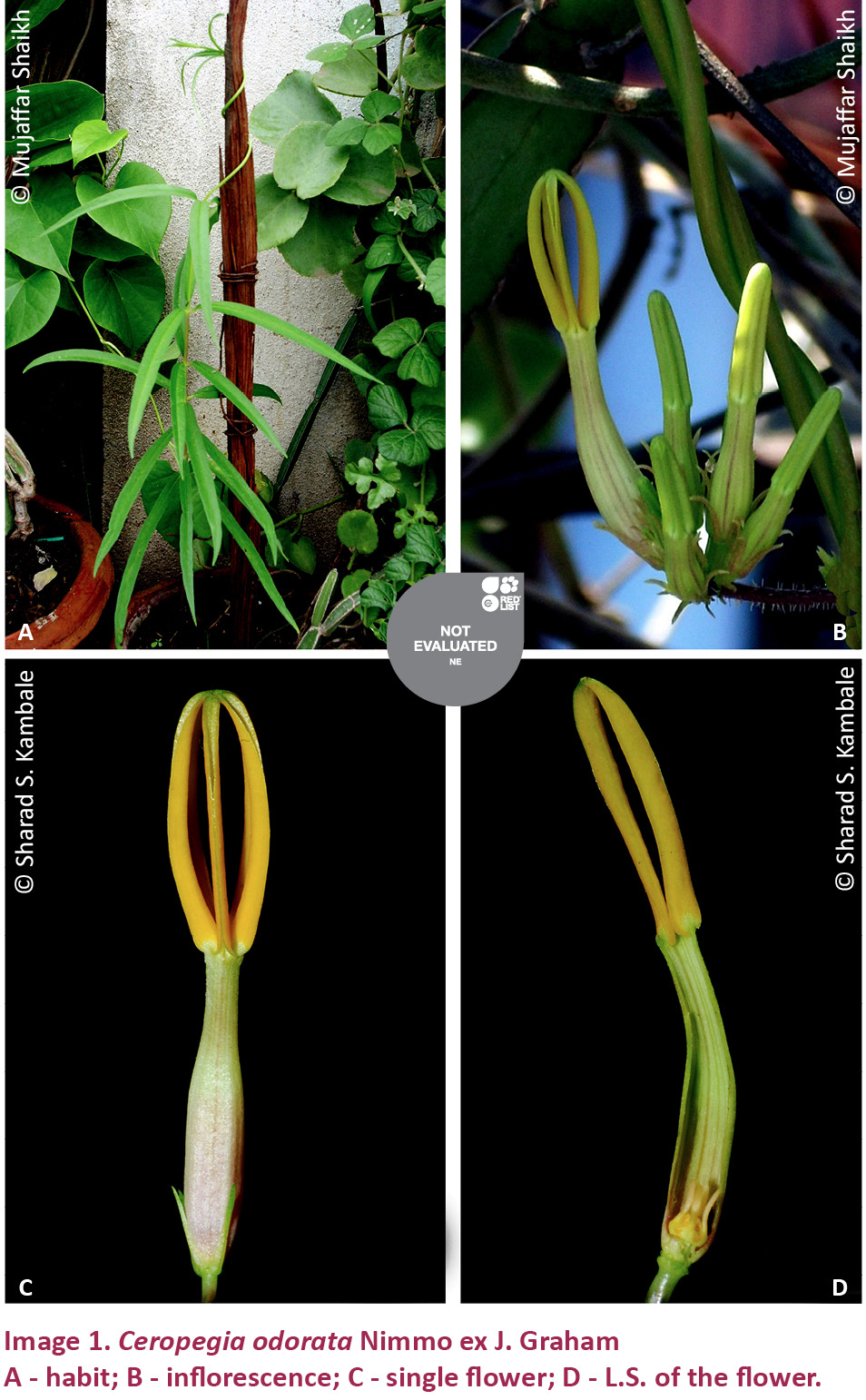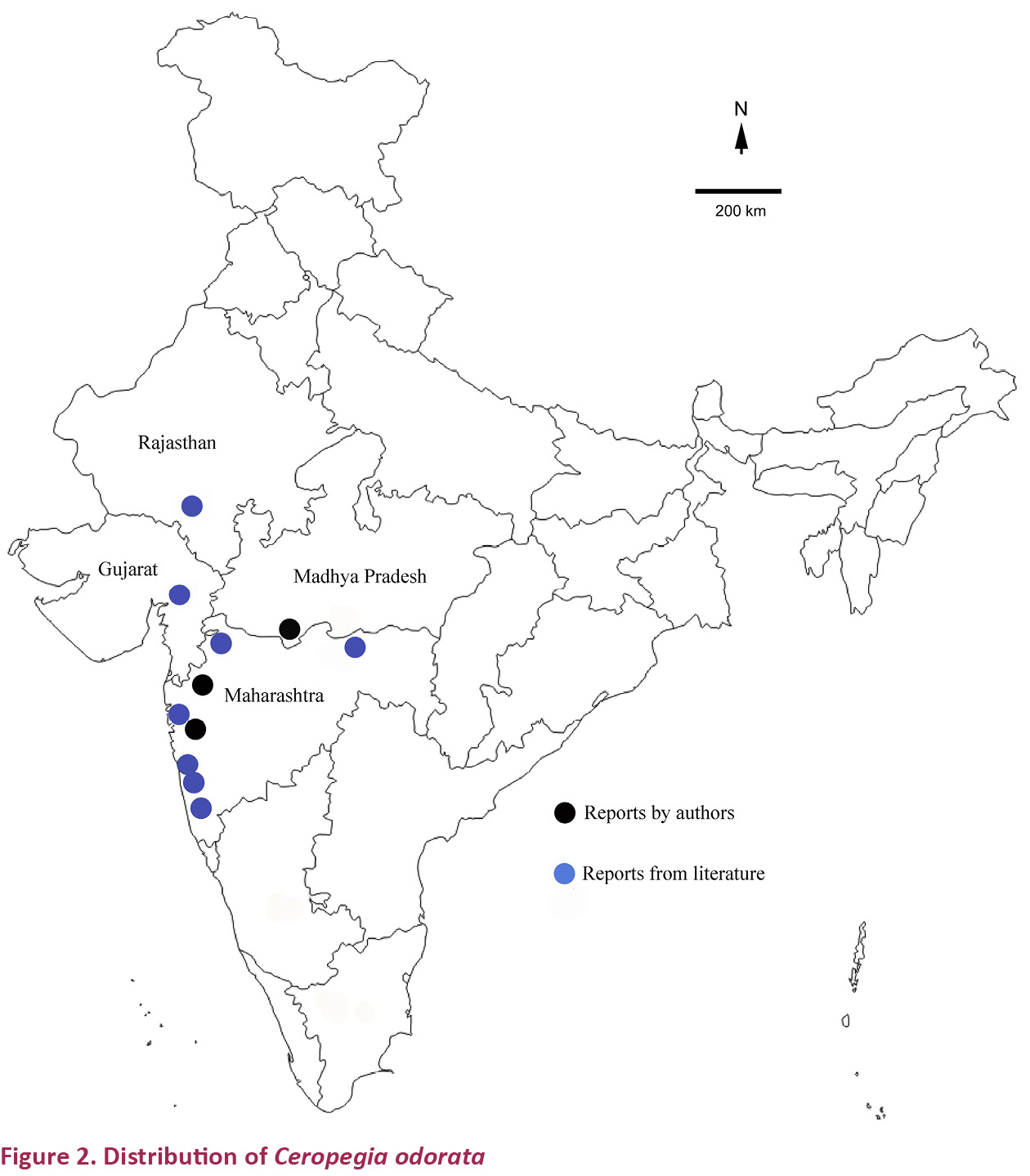Note
An extended distribution of Ceropegia odorata Nimmo ex J. Graham (Apocynaceae: Asclepiadoideae) to the state of Madhya Pradesh, India
Shaikh Mujaffar 1, Sharad S. Kambale 2 & Shrirang R. Yadav 3
1 Department of Botany, Government College Bhikangaon, District- Khargone District, Madhya Pradesh 451331, India
2,3 Angiosperm Taxonomy Laboratory, Department of Botany, Shivaji University, Kolhapur, Maharashtra 416004, India
1 shaikhmujaffar@gmail.com, 2 ceropegias1987@gmail.com (corresponding author), 3 sryadavdu@rediffmail.com
doi: http://dx.doi.org/10.11609/JoTT.o3441.6830-2
Editor: M.K. Vasudeva Rao, Shiv Ranjani Housing Society, Pune, India. Date of publication: 26 January 2015 (online & print)
Manuscript details: Ms # o3441 | Received 18 December 2012 | Final received 16 September 2014 | Finally accepted 13 December 2014
Citation: Mujaffar, S., S.S. Kambale & S.R. Yadav (2015). An extended distribution of Ceropegia odorata Nimmo ex J. Graham (Apocynaceae: Asclepiadoideae) to the state of Madhya Pradesh, India. Journal of Threatened Taxa 7(1): 6830–6832; http://dx.doi.org/10.11609/JoTT.o3441.6830-2
Copyright: © Mujaffar et al. 2015. Creative Commons Attribution 4.0 International License. JoTT allows unrestricted use of this article in any medium, reproduction and distribution by providing adequate credit to the authors and the source of publication.
Funding: University Grants Commission (UGC), New Delhi (F1 - 17.1/2010/MANF- BUD-MAH-6838).
Competing Interest: The authors declare no competing interests.
Acknowledgements: The author (SSK) thanks the University Grants Commission (UGC- MANF-BUD-MAH-6838), New Delhi for financial assistance. He also thanks Dr. K.N. Gandhi, Senior Nomenclatural Registrar, Harvard University Herbarium, Cambridge, Massachusetts, USA for his critical comments on the nomenclature of the species. The authors would also like to thank the anonymous reviewers for their comments on improving this manuscript. Our sincere thanks to anonymous reviewers and the subject editor for the efforts taken to improve the quality of the manuscript. The authors also thank the Head Department of Botany, Shivaji University, Kolhapur and Government College Bhikangaon (MP), India for the laboratory facilities.

During explorations in the Nepanagar Tehsil, Burhanpur District of Madhya Pradesh, the senior author collected interesting Ceropegia in the vegetative (tubers) stage. The tubers were grown in a garden and when the plants flowered they were identified to be of C. odorata Nimmo ex J. Graham, which is not reported in the Flora of Madhya Pradesh (Mudgal et al. 1997) and hence forms a new record for the state of Madhya Pradesh. The herbarium specimens have been deposited at the Herbarium of SNPG Govt. College, Khandwa and Government College Bhikangaon, Madhya Pradesh.
After its type collection it has been reported from Pavagarh and Panchamahal Districts of Gujarat (Sabnis & Bedi 1971) and Mount Abu, Rajasthan (Ansari 1984). It has also been reported from Toranmal forests in Maharashtra (Jagtap et al. 2004) and by the other two authors (SSK & SRY) from Kasara Ghat, Murbad and Karjat region of Maharashtra. The species is sparsely distributed and not more than 15–20 individuals were located. It was reported to be rare by Sabnis & Bedi (1971), Yadav (1997), Nayar & Sastry (2000), Jagtap & Das (2001) and Yadav & Kamble (2008). Singh et al. (2014) recently reported it from Bhoste Ghat (Khed), Matwan (Dapoli) and Hatiwale (Rajapur) in Ratnagiri District of Maharashtra. It is therefore evident that the species has a broad range of distribution in the states of Rajasthan, Gujarat, Madhya Pradesh and Maharashtra. Moreover the species is known with a good number of populations from Maharashtra (Fig. 1).
Ceropegia odorata Nimmo ex J. Graham, Cat. Pl. Bombay 118. 1839.
Lectotype: (Step I: vide Huber, 1957: 69. Step II: vide Ansari, 1984: 26-27): India, Maharashtra, Concan, Salsette, Island (Bombay) Stocks & Law 239 K! (K000894261).
Specimens Examined: 4501, 04.Viii.2012, 21027’50.59”N & 76024’04.72”E, Mashak Pahar, Nepanagar Tehsil, Burhanpur District, Madhya Pradesh, India, coll. M. Shaikh (deposited at Herbarium of SNPG Govt. College, Khandwa, Madhya Pradesh); 4561, 05.vi.2013, tuber collected from Mashak Pahar and grown in Garden, coll. M. Shaikh (deposited at Government College Bhikangaon, Madhya Pradesh).
Perennial twinning herbs; rootstock tuberous; tubers 1–2.5 cm in diam., depressed, sub-globose, roots fibrous. Stem slender about 2m in length, sparsely hairy, unbranched. Leaves whorled or opposite, decussate, usually three at lower nodes, opposite at upper nodes, lower leaves large, broadly lanceolate, sub-sessile, 6–12.5x1.1–2.6 cm in length; fleshy, pubescent above and along margin, glabrous beneath except for midrib and veins, acute or acuminate at apex, upper narrow lanceolate, petiolate; petiole 0.4–0.6 cm in length, channeled, channel margins hairy, glabrous otherwise. Inflorescence lateral umbellate pedunculate cyme, peduncles pubescent, 0.5–2 cm, terete, 6–10 flowered; flowers yellow, sweet scented; bracts 0.35–0.55 cm, linear, almost glabrous; pedicels up to 0.5 cm, glabrous. Calyx 5-partite, sepals 0.55–0.6 cm, linear – acuminate, hairy on mid nerve. Corolla 3.2cm long, corolla tube up to 1.6cm long, slightly curved, dilated at base, glabrous, yellow with purple lines and hairy within dilated part, corolla lobes yellow, 1–1.3 cm long, narrow, folded back, glabrous, connate at tips, forming an oval head. Corona biseriate, glabrous; outer corona entire ca. 0.12cm, inner corona of five elongated, linear-oblong, pubescent, subulate, 0.2–0.3 cm long processes. Gynostegium ca. 1.5mm, long; pollinium yellow, minute, ovate-oblong in shape, corpusculum, reddish-brown, caudicle short. Follicles up to 10cm long, tapering towards apex. Seeds 0.4x0.2 cm, brown, ovate, comose; coma ca. 3.5cm long, silky (Image 1).

Notes: Grows in rocky areas amongst grasses, in association with Dendrocalamus strictus (Roxb.) Nees and Tylophora fasciculata Buch.-Ham. ex Wight. Flowers of the species are yellow and sweet scented which is an unusual feature in the genus. The evolution of fragrance in the otherwise non-fragrant genus is an interesting phenomenon. Whether this character has any ecological significance needs to be verified with further studies (Jagtap et al. 2004). A step towards the conservation of species by using biotechnological tools has been taken by the Department of Botany, Shivaji University, Kolhapur in collaboration with Agharkar Research Institute (ARI), Pune, and Forest Department, Maharashtra, (MS) India
Flowering and fruiting: August–October
Distribution: India: Gujarat, Madhya Pradesh, Maharashtra and Rajasthan.

Nomenclatural notes: Nimmo provided the name and John Graham (1839) provided the description for the species. Although Graham provided a very meager description i.e., “Flowers yellow, fragrant; so unusual in this genus”, the phrase ‘unusual in the genus’ makes it different from other species in the genus. Hence, the species was effectively published then; but it was considered invalid by earlier workers (Huber 1957; Ansari 1984). Hooker (1883) cited the species as C. odorata Nimmo and provided an adequate description and this could be the reason why earlier workers have cited the species as C. odorata Nimmo ex. Hook. f. and C. odorata Hook. f. After a discussion with Dr. K.N. Gandhi, we came to the conclusion that the species had to be referred to as C. odorata Nimmo ex J. Graham.
Singh et al. (2014) designated the neotype for the name with the argument that Nimmo’s collection is missing which was cited by Hooker (1883); however Hooker cited both Nimmo and Law after the habitat details. Huber (1957) cited ‘Typus: Socks & Law in Herb. K’; however there are two sheets of the species collected by Stocks and Law at K. So what Huber did amounts to lectotype step I. Ansari (1984) for the first time cited the exact collection number i.e., Stocks & Law 239 as a lectotype which amounts to the lectotype step II. Singh et al. (2014) completely ignored these two basic references on Ceropegia and by mistake designated the neotype, which is an error. The correct citation for the lectotype has been given in this communication.
References
Ansari, M.Y. (1984). Flora of India: Fascicle 16. Asclepiadaceae: Genus - Ceropegia. Botanical Survey of India, Kolkata, 33pp.
Graham, J. (1839). A Catalogue of the Plants Growing in Bombay and its Viscinity: Bombay. Government Press, 118pp.
Hooker, J.D. (1883). The Flora of British India - Volume 4. L. Reeve & Co., London, 780pp.
Huber, H. (1957). Revision der Gattung Ceropegia. Memorias da Sociedade Broteriana 12: 1–203.
Jagtap, A.P. & S.K.D. Das (2001). Asclepiadaceae, pp. 345–357. In: Singh, N.P., S. Lakshminarasimhan, S. Karthikeyan & P.V. Prasanna (eds.). Flora of Maharashtra State, Dicotyledons - Volume 2. Botanical Survey of India, Kolkata,
Jagtap, S., S. Deokule & A. Watve (2004). Occurrence of threatened fragrant Ceropegia in Toranmal forests, Maharashtra. Current Science 87(5): 553–554.
Mudgal, V., K.K. Khanna & P. Hajra (1997). Flora of Madhya Pradesh - Volume 2. Botanical Survey of India, Kolkata, 681pp.
Nayar, M.P. & A.R.K. Sastry (2000). Red Data Book of Indian Plants - Volume 1. Botanical Survey of India, Kolkata, 64pp
Sabnis, S.D. & S.J. Bedi (1971). Ceropegia odorata Hook. f. (Asclepiadaceae): a little- known plant of western India. Kew Bulletin 25(1): 57–59
Singh, R.K., S. Patil & J.S. Jalal (2014). Resurrecting the type locality of ceropegia odorata (Apocynaceae) after 175 years. Taprobanica 6(2): 79–82.
Yadav, S.R. (1997). Rare flowering plant species of Maharashtra, their potential values, utilization and conservation in sustainable development. Proceedings of the National Conference on Dimensions of Environmental Stress in India, 35-44pp
Yadav, S.R. & M.Y. Kamble (2008). Threatened ceropegias of the Western Ghats and strategies for their conservation, pp. 123–134. In: Rawat, G.S. (ed.). Special Habitats and Threatened Plants of India. ENVIS Bulletin: Wildlife and Protected Areas, Vol. 11(1). Wildlife Institute of India, Dehradun, India.